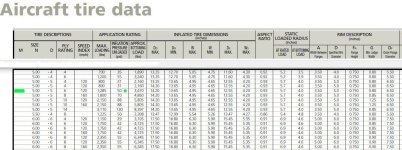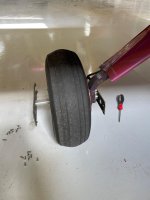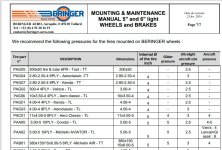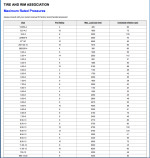Van's Air Force
You are using an out of date browser. It may not display this or other websites correctly.
You should upgrade or use an alternative browser.
You should upgrade or use an alternative browser.
Tire Pressures?
- Thread starter rockitdoc
- Start date
Many opinions out there. One my 10 I run 45 all around. On the 6 I run 45 on the mains and 50 on the nose. Do your home work. Once you get below around 30 PSI on these little tires, tube failure rate goes up a lot.
How many plies in those tires? Are they tubeless or tubed?
D-Dubya
Well Known Member
Larry's right...there are many opinions out there on this. Here's what Van's says, but this isn't specific to any model:
The NOSE wheel tire pressure should be between 25-35psi. Less is better as it increases the tire drag, which will help damp any shimmy. The MAIN tires should be inflated to between 25 and 35 PSI and be equally pressurized. The balance of the wheel/ tire assemblies is important as well – all of them!
The NOSE wheel tire pressure should be between 25-35psi. Less is better as it increases the tire drag, which will help damp any shimmy. The MAIN tires should be inflated to between 25 and 35 PSI and be equally pressurized. The balance of the wheel/ tire assemblies is important as well – all of them!
Carl Froehlich
Well Known Member
SNIP Once you get below around 30 PSI on these little tires, tube failure rate goes up a lot.
This.
I know of one RV-10 that ran at 30 PSI or less and spun the tire on the wheel breaking off the valve stem - twice. After he finally took my advice to go to 42 pounds the problem ended.
If you have nose wheel shimmy dropping the pressure addresses the symptom, not the problem. If you don’t have the Matco nose wheel axle or whatever Van’s is selling these days as a rod between the bearings, get one. While the nose wheel needs to be balanced, my experience is that the main gear tire balance is even more important to minimizing nose wheel shimmy.
Nose wheel shimmy can also be caused by main tires out of round.
Carl
The Michelin and Goodyear tire data books provide the best guidance. Clip below for your hard drive.
A 5.00-5 6 ply is fully inflated at 50 psi, no load, to provide a capacity of 1285 lbs per tire. Minimum required pressure to not exceed deflection limits is proportional to weight. So, for an RV-14 at 2050 lbs, we can adjust down a little. I don't have an RV-14 weight and balance in front of me, but for example, I'll assume 1800 on the mains at gross weight, or 900 per tire.
(900 x 50) / 1285 = 35 psi unloaded, minimum
Pressures are adjusted upwards 4% when loaded, so...
35 x 1.04 = 36.4 psi, loaded, minimum
I stress minimum for good reason. At minimum and below, you're in tube and tire damage territory. There is no downside to operating at maximum pressure, other than the classic shimmy problem on the round leg models.
The above is fact. Anecdotally, I've operating my RV-8 for 1200 hours with the same tubes, at 50 psi since day one.
At Triple Tree, I asked a Beringer rep about minimum inflation pressure when run tubeless. He declined to offer an opinion, stating inflation pressure is determined by the airframe manufacturer. In addition to the above deflection limit, I suspect running tubeless at 25 to 35 psi will eventually result in deflation if the tire is side loaded significantly, like a bad swerve or a firm arrival with one wing low in a heavy crosswind. The Michelin book does not seem to differentiate tube and tubeless, so I'm pretty sure the above calculated minimums still apply with tubeless Beringers.
I was amused by the Beringer rep's claim of tubeless superiority, which could be summed as "It's always the tube that fails". Well, yeah, that's the part which holds the air. Results are not going to be a lot better running underinflated with a tubeless wheel.
.
A 5.00-5 6 ply is fully inflated at 50 psi, no load, to provide a capacity of 1285 lbs per tire. Minimum required pressure to not exceed deflection limits is proportional to weight. So, for an RV-14 at 2050 lbs, we can adjust down a little. I don't have an RV-14 weight and balance in front of me, but for example, I'll assume 1800 on the mains at gross weight, or 900 per tire.
(900 x 50) / 1285 = 35 psi unloaded, minimum
Pressures are adjusted upwards 4% when loaded, so...
35 x 1.04 = 36.4 psi, loaded, minimum
I stress minimum for good reason. At minimum and below, you're in tube and tire damage territory. There is no downside to operating at maximum pressure, other than the classic shimmy problem on the round leg models.
The above is fact. Anecdotally, I've operating my RV-8 for 1200 hours with the same tubes, at 50 psi since day one.
At Triple Tree, I asked a Beringer rep about minimum inflation pressure when run tubeless. He declined to offer an opinion, stating inflation pressure is determined by the airframe manufacturer. In addition to the above deflection limit, I suspect running tubeless at 25 to 35 psi will eventually result in deflation if the tire is side loaded significantly, like a bad swerve or a firm arrival with one wing low in a heavy crosswind. The Michelin book does not seem to differentiate tube and tubeless, so I'm pretty sure the above calculated minimums still apply with tubeless Beringers.
I was amused by the Beringer rep's claim of tubeless superiority, which could be summed as "It's always the tube that fails". Well, yeah, that's the part which holds the air. Results are not going to be a lot better running underinflated with a tubeless wheel.
.
Attachments
Last edited:
JonJay
Well Known Member
Dan did some deflection testing or theorizing a few years ago. I was a disbeliever, always risky when Dans involved, and kept running my 6 around 25psi (kept shimmy away on new Desser Monsters).
I had an unusual gust pick up one wing and slam it back down causing enough deflection that I damaged a wheel pant. I started running them at 35psi and ina few hours the new retreads “settled in”, no more shimmy.
Adjust for the 14’s weight and heed Dans advice on under inflation.
I had an unusual gust pick up one wing and slam it back down causing enough deflection that I damaged a wheel pant. I started running them at 35psi and ina few hours the new retreads “settled in”, no more shimmy.
Adjust for the 14’s weight and heed Dans advice on under inflation.
dmattmul
Well Known Member
3.5 - 4.0 atmospheres
I'll try and find the document later but I'm pretty sure Beringer recommends 3.5 to 4.0 atmospheres * 14.7 for the RV-14. I'll try and find the document later. I've always filled mine to 60 psi and when they get to 50 psi re-air them. I am using SensAir so easy to monitor. This is one of my mains at 450 hrs. and one flip and rotation. Nose same pressures and never had a shimmy.
For this doc 4 is the correct answer it seems.
I'll try and find the document later but I'm pretty sure Beringer recommends 3.5 to 4.0 atmospheres * 14.7 for the RV-14. I'll try and find the document later. I've always filled mine to 60 psi and when they get to 50 psi re-air them. I am using SensAir so easy to monitor. This is one of my mains at 450 hrs. and one flip and rotation. Nose same pressures and never had a shimmy.
For this doc 4 is the correct answer it seems.
Attachments
Last edited:
For this doc 4 is the correct answer it seems.
I know you know, but for those who might miss the fine print...that's 4 atmospheres with 10 ply tires.
4 bar would be fine with 8 ply also. Minimum pressure for 900 lbs per tire works out to be 35~36 psi for 6, 8, and 10 ply....no surprise, as they are dimensionally the same.
Last edited:
On my -14A I have Michelin Air 5.00x5 tires on Beringer wheels/brakes. I cannot find any reference to what pressures I should run.
Any ideas?
from Dresser:
see attached.








